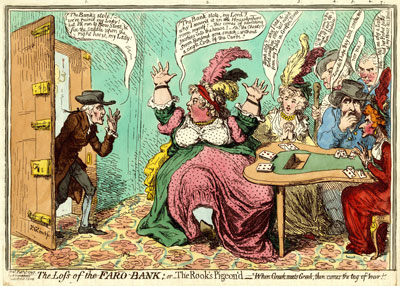The Loss of the Faro Bank, or the Rook's Pigeon'd.
This is the third of four prints created by Gillray in the 1790's on the subject of illegal gambling, especially by women of fashiion. The others included: Modern Hospitality (March 1792), Exaltation of Faro's Daughters (May, 1796), and Discipline a la Kenyon (March, 1797).

[February 2, 1797]
© Trustees of the British Museum
This particular print was prompted by newspaper accounts of the theft of the Faro bank at the portly Lady Buckinghamshire's house in St. James's Square, on January 30, 1797. But since the activities of the group of women known as Faro's daughters had been notorious since at least the early 1790s, Gillray incoporates details from other sources that would have been familiar to him and to his audience.
The earliest extended notice of the robbery dates from February 1st.
On Monday, [January 30] between twelve o'clock at noon and the same hour at night, a box was stolen from the Earl of BUCKINGHAMSHIRE'S, in Charles-Street, St. James's-square, containing Five Hundred Guineas, the joint property of the Countess of B. and two other-Ladies, co-proprietors of the FARO BANK.
The robbery was not found out until midnight, at the moment when the company had assembled and the play was about to begin. On discovering the misfortune, Townshend, the police officer, was sent for; and though every servant's box in the house was searched, the robbery is still enveloped in mystery. (Evening Mail. Page 2)
A subsequent trial for illegal gambling, held on Saturday March 4, identified the "two other-Ladies" playing Faro with Lady Buckinghamshire that night as Lady Elizabeth Luttrell and Mrs Sturt, but Gillray may not have known that. So he chose to portray two of the other most infamous of Faro's daughters—Lady Concannon (next to Lady Buckinghamshire and identified by the reference to her own "table in Grafton Street") and the hook-nosed Lady Archer dressed in red whom he had portrayed gambling in Modern Hospitality. And to help fill out the participants at the table, Gillray added the inveterate gambler George Hanger with his well known cudgel (shelalee). "The Mount" was a coffe shop frequented by Hanger on Grosvenor Street and featured in Georgey a' Cock-Horse.
After the robbery, there was considerable speculation about the perpetrator(s). Suspicion among several newspapers fell on Lady Buckinghamshire herself or her guests. The Evening Mail slyly wondered whether "any body broke into the House, or whether the Box [i.e. the Faro Bank] broke out of the House." And later in the same edition, more pointedly, it admitted that "A noble countess would never have been suspected of a little trick at Faro if it had not been for her friends. No stranger to her Ladyship could have dreamed of such a thing." (page 4)
Never loathe to satirize the Whigs, Gillray himself has no doubt where to assign blame for the robbery. He portrays the Whig leader Charles James Fox looking more than usually furtive, and whispering "I hope they don't smoke me. To which his partner W.B. Sheridan replies, "Nor me." To reinforce his point, Gillray puts the same suspicion in Lady Buckinghamshire's mouth—this is what "comes of admitting Jacohins into the house."
The final stroke of Gillray's satire is delivered by the caption to the print derived from the play The Rivals Queens (~1677) by Nathaniel Lee: ":'When Greeks join'd Greeks, then was the tug of war'." The point is that this was, in the final analysis, a theft among thieves--all of them guilty.
NOTE: One of the striking qualities of 18th century newspapers is how witty they were. Their aditors obviously enjoyed reporting on some of the more absurd happenings of the day, and would often include satitric poems on current events. If the piece were particularly successful, it would shortly appear in more than one publication. Such is the case with a delightful poem called The Faro Bank! which appeared in the Evening Mail on February 1st and in the London Times on February 3rd. Gillray no doubt enjoyed the satire which is not so different from his own.
Sources and Reading
- Commentary from the British Museum on The Loss of the Faro Bank, or the Rook's Pigeon'd..
- Tim Clayton, James Gillray: A Revolution in Satire p. 171, 249
- Diana Donald, The Age of Caricature, pp. 105-6.
- "Albinia Hobart," Wikipedia
- "Faro Ladies," Wikipedia
- "Faro (banking game)," Wikipedia
- "George Hanger, 4th Baron Coleraine," Wikipedia
- "George Hobart, 3rd Earl of Buckinghamshire," Wikipedia
- Thomas Wright and R.H. Evans, Historical and Descriptive Account of the Caricatures of James Gillray #423.
- Thomas Wright and Joseph Grego, The Works of James Gillray, the Caricaturist; With the History of His Life and Times, p. 227.
Comments & Corrections
NOTE: Comments and/or corrections are always appreciated. To make that easier, I have included a form below that you can use. I promise never to share any of the info provided without your express permission.